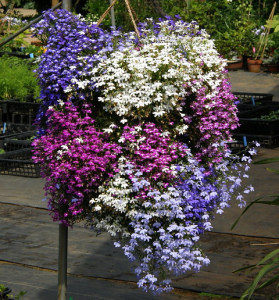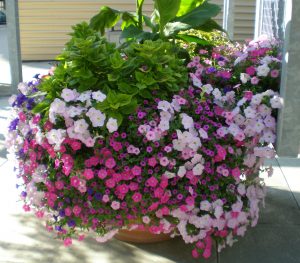Feed URL: https://blogs.kent.ac.uk/estates-news/2020/05/13/top-5-bedding-plants/feed/?withoutcomments=1
During this tumultuous time, getting out in the garden can be a fantastic way of stimulating both your physical and mental wellbeing. Gardening is known to be a great source of relaxation, pleasure, and fulfillment. From gardens, to window boxes, or even just a windowsill, gardening can be achieved in the smallest of spaces and with the tiniest of budgets. In this article, Chris Wright our Landscape Supervisor, shares his top 5 bedding plants that can be enjoyed over the next few months:
Before I started at the University, I managed a family-run plant Nursery. Working in this environment enhanced my love for seasonal bedding plants, which I hope has shown with the development of bedding plants in selected locations on campus. I love seasonal bedding due to the impact of the colours they can have to a garden, flower bed, planter or hanging basket all season long. Don’t get me wrong, I understand that with the environmental challenges that we all face, bedding plants can be a strain on precious resources but by using drought-tolerant plants or greywater I think they still have their place in our gardens.
Here are my favourite 5 bedding plants and some tips for planting them in the right conditions:
Bacopa plants are most easily done in containers. This allows for the consistent moisture necessary to avoid the interruption of flowering. Use Bacopa trailing annual as a filler plant in mixed containers and hanging baskets. Grow Bacopa trailing annual in full sun to part shade location. The tender annual is sometimes bothered by aphids, which can be dispersed with a strong blast of water from the sprayer. If aphids persist on new growth, treat them with a soapy spray.
2. lo belia ‘String of Pearls’:
belia ‘String of Pearls’:
‘String of Pearls’ is a spreading annual to 25cm in height, with neat foliage and flowers in shades of light and deep blue, purple or white, some with a white eye. They grow in deep, fertile, reliably moist soil in full sun or partial shade. Apply a balanced fertilizer every two weeks during spring and early summer and a nitrogen-free fertilizer every two weeks from mid-summer onwards. Slugs may be a problem however.
 3. Geraniums (Pelargonium x hortorum):
3. Geraniums (Pelargonium x hortorum):
Geranium care is pretty basic, so perfect for a beginner gardener. In addition to watering, which should be done deeply and at least weekly outdoors (though potted plants may need daily watering in hot weather), fertilizing is usually necessary. Regular deadheading of spent blooms will also help encourage additional blooming. When watering outdoor plants, it is best to avoid overhead irrigation, as this can lead to pests or disease issues. Geranium plants root easily from cuttings and can be propagated in fall for overwintering of outdoor plants. They can also be dug up and brought inside.
New Guinea Impatiens are a great choice for a long-blooming flower for a sunny spot in your garden. Like their shade-loving cousins the common impatiens, New Guinea impatiens form small clumps and hold their many flowers above their foliage, where they make a colourful display. No deadheading is required to keep them repeat blooming for months. With few pests or problems, New Guinea impatiens offer low maintenance and high performance. These plants need watering regularly. Do not let them remain dry for extended periods or they will stop blooming, decline, and could potentially die.
5. Petunia:
Petunias are one of our most popular summer bedding plants, flowering throughout the summer until the first severe frosts of autumn. Their mass of flowers bring lots of great colour to gardens. The compact, bushy varieties are perfect for planting in beds and borders and the trailing types brighten up hanging baskets and for flowing down the edges of containers. There is great variety in petunia flowers: a wide range of colours; both single and double blooms; smooth or ruffled petals; solid single, striped, veined or picotee-edged colours; and even fragrance. Recent breeding has also removed the scourge of old petunia varieties turning to mush in a wet summer. Keep the soil moist by watering regularly during prolonged dry periods in summer. Plants in containers will need regular, possibly daily watering. The aim is to keep the compost evenly moist but don’t overwater, as too much water will cause the plants to become leggy with few flowers. Feed regularly throughout summer with liquid plant food to ensure a continuous supply of flowers. A high potash liquid plant food will encourage more, high quality blooms over a long flowering period until the first autumn frosts. Removing faded flowers and any developing seed pods will prolong the display. Straggly plants can be cut back quite hard and then fed with liquid plant food to produce fresh new growth and a profusion of flowers.
I hope these flowers provide you with a bit of inspiration and help to get you gardening over the next few weeks.
If you would like to read more on gardening and its health and wellbeing benefits, the RHS offers some fascinating articles which can be found at: https://www.rhs.org.uk/advice/health-and-wellbeing



